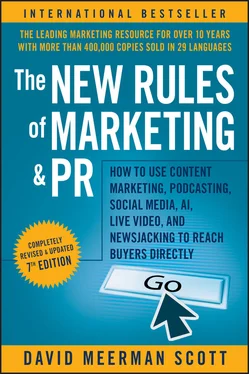1 ...7 8 9 11 12 13 ...24 Only the best PR people had personal relationships with the media and could pick up the phone and pitch a story to the reporter for whom they had bought lunch the month before.
Prior to 1995, outside of paying big bucks for advertising or working with the media, there just weren’t any significant options for a company to tell its story to the world.
The web has changed the rules. Today, organizations are communicating directly with buyers.
Yes, the Media Are Still Important
Allow me to pause again for a moment to say that the mainstream and trade media are still important components of a great public relations program. On my blog and on the speaking circuit, I’ve sometimes been accused of suggesting that the media are no longer relevant. That is not my position. The media are critically important for many organizations. A positive story in Rolling Stone propels a rock band to fame. An article in the Wall Street Journal brands a company as a player. A consumer product talked about on the Today show gets noticed. In many niche markets and vertical industries, trade magazines and journals help decide which companies are important. However, I do believe that, while all these outlets are important aspects of a larger PR program, there are easier and more efficient ways to reach your buyers. And here’s something really neat: If you do a good job of telling your story directly, the media will find out. And then they will write about you!
Public relations work has changed. PR is no longer just an esoteric discipline where companies make great efforts to communicate exclusively to a handful of reporters who then tell the company’s story, generating a clip for the PR people to show their bosses. These days, great PR includes programs to reach buyers directly. The web allows direct access to information about your products, and smart companies understand and use this phenomenal resource to great advantage.
The Internet has made public relations public again, after years of almost exclusive focus on media. Blogs, online video, news releases, and other forms of web content let organizations communicate directly with buyers.
Press Releases and the Journalistic Black Hole
In the old days, a press release was actually a release to the press, so these documents evolved as an esoteric and stylized way for companies to issue their “news” to reporters and editors. Because it was assumed that nobody saw the actual press release except a handful of reporters and editors, these documents were written with the media’s existing understanding in mind.
In a typical case, a tiny audience of several dozen media people got a steady stream of product releases from a company. The reporters and editors were already well versed on the niche market, so the company supplied very little background information. Jargon was rampant. What’s the news? journalists would think as they perused the release. Oh, here it is—the company just announced the Super Techno Widget Plus with a New Scalable and Robust Architecture. While this might mean something to a trade magazine journalist, it is just plain gobbledygook to the rest of the world. Since press releases are now seen by millions of people who are searching the web for solutions to their problems, these old rules are obsolete.
The only way to get ink and airtime was through the media.
Companies communicated to journalists via press releases.
Nobody saw the actual press release except a handful of reporters and editors.
Companies had to have significant news before they were allowed to write a press release.
Jargon was okay because the journalists all understood it.
You weren’t supposed to send a release unless it included quotes from third parties, such as customers, analysts, and experts.
The only way buyers would learn about the press release’s content was if the media wrote a story about it.
The only way to measure the effectiveness of press releases was through clip books, which noted each time the media deigned to pick up a company’s release.
PR and marketing were separate disciplines run by different people with separate goals, strategies, and measurement techniques.
The web has transformed the rules, and you must transform your PR strategies to make the most of the web-enabled marketplace of ideas.
The vast majority of organizations don’t have instant access to mainstream media for coverage of their products. People like you and me need to work hard to be noticed in the online marketplace of ideas. By understanding how the role of PR and the press release has changed, we can get our stories known in that marketplace.
There are some exceptions. Very large companies, very famous people, and governments might all still be able to get away with using the media exclusively, but even that is doubtful. These name-brand people and companies may be big enough, and their news just so compelling, that no effort is required of them. For these lucky few, the media may still be the primary mouthpiece.
If you are J. K. Rowling and you issue a press release about a new book, the news will be picked up by the media.
If Apple Computer CEO Tim Cook announces the company’s new iPhone, the news will be picked up by the media.
If the president of the United States announces a pick to fill a vacancy on the U.S. Supreme Court, the news will be picked up by the media.
If you are smaller and less famous but have an interesting story to tell, you need to tell it yourself. Fortunately, the web is a terrific place to do so.
Learn to Ignore the Old Rules
To harness the power of the web to reach buyers directly, you must ignore the old rules. Public relations is not just about speaking through the media, although the media remain an important component. Marketing is not just about one-way broadcast advertising, although advertising can be part of an overall strategy.
I’ve noticed that some marketing and PR professionals have a very difficult time changing old habits. These new ideas make people uncomfortable. When I speak at conferences, people sometimes fold their arms in a defensive posture and look down at their shoes. Naturally, marketing and PR people who learned the old rules resist the new world of direct access. It means that to be successful, they need to learn new skills. And change is not easy.
But I’ve also noticed that many enlightened marketing executives, CEOs, entrepreneurs, nonprofit executives, and professionals jump at the chance to tell their stories directly. These people love the new way of communicating with buyers and are eager to learn. Smart marketers are bringing success to their organizations each and every day by communicating through the web.
Here’s how to tell if the new rules are right for you. Consider your goals for communicating via marketing and public relations. Are you buying that Super Bowl ad to score great tickets to the game? Are you designing a creative magazine ad to win an award for your agency? Do you hope to create a book of press clips from mainstream media outlets to show to your bosses? Does your CEO want to be on TV? If the answers to these questions are yes, then the new rules (and this book) are not for you.
However, if you’re like millions of smart marketers and entrepreneurs whose goal is to communicate with buyers directly, then read on. If you’re working to make your organization more visible online, then read on. If you want to drive people into your company’s sales process so they actually buy something (or apply or donate or join or submit their names as leads), then read on. I wrote this book especially for you.
Читать дальше












